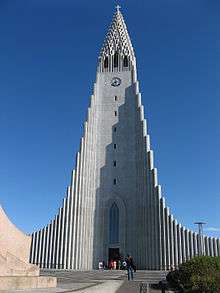Hallgrímskirkja
| Church of Hallgrímur | |
|---|---|
| Hallgrímskirkja | |
 Hallgrímskirkja | |
| 64°08′31″N 21°55′39″W / 64.14194°N 21.92750°W | |
| Country | Iceland |
| Denomination | Lutheran |
| Website |
hallgrimskirkja |
| History | |
| Founded | 1945 |
| Consecrated | 26 October 1986 |
| Architecture | |
| Status | Active |
| Functional status | Parish Church |
| Architect(s) | Guðjón Samúelsson |
| Style | Expressionist architecture |
| Completed | 1986 |
| Specifications | |
| Spire height | 73 meters |
| Administration | |
| Parish | Reykjavík |
| Clergy | |
| Bishop(s) | Agnes M. Sigurðardóttir |
Hallgrímskirkja (Icelandic pronunciation: [ˈhatlkrimsˌcʰɪrca], church of Hallgrímur) is a Lutheran (Church of Iceland) parish church in Reykjavík, Iceland. At 73 metres (244 ft), it is the largest church in Iceland and among the tallest structures in Iceland.[1] The church is named after the Icelandic poet and clergyman Hallgrímur Pétursson (1614 to 1674), author of the Passion Hymns.[2]
Description
Situated in the centre of Reykjavík, it is one of the city's best-known landmarks and is visible throughout the city. State Architect Guðjón Samúelsson's design of the church was commissioned in 1937. He is said to have designed it to resemble the basalt lava flows of Iceland's landscape.[3] The design is similar in style to the expressionist architecture of Grundtvig's Church of Copenhagen, Denmark, completed in 1940.
It took 41 years to build the church with construction started in 1945 and ended in 1986, while the landmark tower being completed long before the church's actual completion. The crypt beneath the choir was consecrated in 1948, the steeple and wings were completed in 1974,[3] and the nave was consecrated in 1986.[1] The interior is 1,676 square metres. In 2008, the church underwent a major restoration of the main tower, and was covered in scaffolding. In late 2009, restoration was completed and the scaffolding was removed.
The church houses a large pipe organ by the German organ builder Johannes Klais of Bonn. It has electronic action, the Pipes being remote from the four manuals and pedal console. There are 102 ranks, 72 stops and 5275 pipes.[1] It is 15 metres tall and weighs 25 tons. Its construction was finished in December 1992. It has been recorded by Christopher Herrick in his Organ Fireworks VII CD and by Mattias Wager on his CD Live at Vatnajökull.
The church is also used as an observation tower. An observer can take a lift up to the viewing deck and view Reykjavík and the surrounding mountains.
The statue of explorer Leif Eriksson (c. 970 – c. 1020) by Alexander Stirling Calder in front of the church predates its construction. It was a gift from the United States in honor of the 1930 Alþingi Millennial Festival, commemorating the 1000th anniversary of Iceland's parliament at Þingvellir in 930 AD.[3]
Views of Hallgrímskirkja
- Side view of the Hallgrímskirkja.
 Hallgrímskirkja at night.
Hallgrímskirkja at night. New Year's Eve at the Hallgrímskirkja.
New Year's Eve at the Hallgrímskirkja.- View from the Hallgrímskirkja in June 2014
 Hallgrímskirkja viewed across Tjörnin
Hallgrímskirkja viewed across Tjörnin
Opening Hours
- Winter (October – April): 9 am – 5 pm.
- Summer (May– September): 9 am – 9 pm.
References
- 1 2 3 Organ Fireworks VII – Christopher Herrick at the organ of the Hallgrimskirkja (CD). Hyperion. 1997.
- ↑ Other Icelandic churches named in memory of Hallgrímur Pétursson are the Hallgrímskirkja in Saurbær, where Pétursson was minister and, since 1957, the is:Hallgrímskirkja í Vindáshlíð (Kjós).
- 1 2 3 Noyes, David (March–April 2009). "Iceland – Europe's coolest little hot spot". Going Places. AAA: 28.
- ↑ http://en.hallgrimskirkja.is/information/
External links
| Wikimedia Commons has media related to Hallgrímskirkja. |
- Hallgrímskirkja's official website (Icelandic)
- Hallgrímskirkja on the Icelandic Church Map
- Aerial photo of Hallgrímskirkja on Google Maps
Coordinates: 64°08′31″N 21°55′39″W / 64.14194°N 21.92750°W